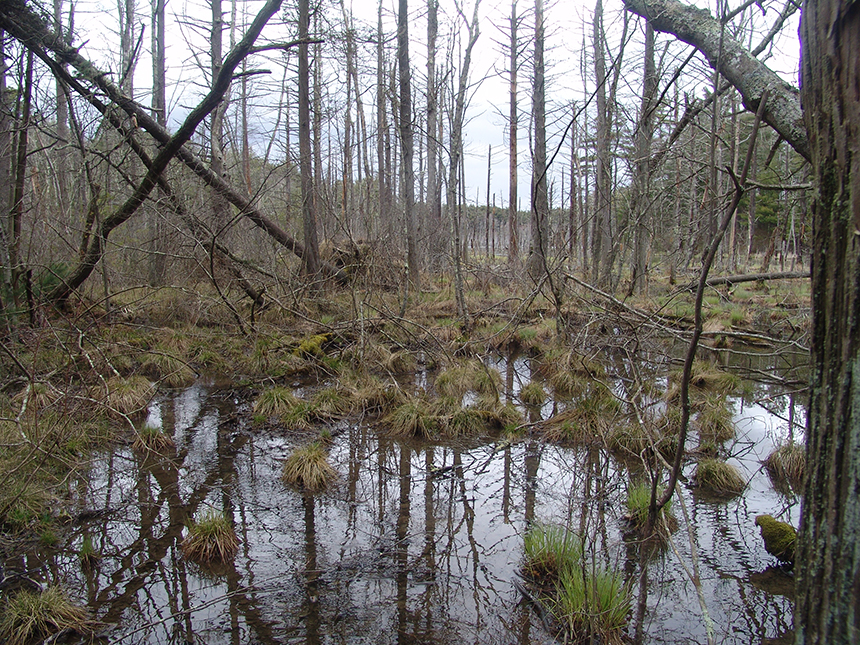By FRANK CARINI/ecoRI
News staff


Three summers ago the General Assembly passed and Gov. Gina Raimondo signed into law legislation that would create statewide standards aimed to both improve wetlands protections and streamline construction permitting.
The details of this new
statewide approach, however, remain murky, as the Rhode Island Department of
Environmental Management (DEM) has yet to create the standards. Michael Healey,
DEM’s chief public affairs officer, recently told ecoRI News that the work
required is nearing completion.
“DEM has been working diligently on this project, having recodified almost 90 percent of our regulations (3,900 pages of the total 4,500 pages encompassed in 184 regulations),” he wrote in an e-mail. “Wetlands, stormwater, and underground storage tanks are among the remaining program areas requiring attention.”
In June 2016, the General Assembly passed and Raimondo signed an update to the Rhode Island Administrative Procedures Act. The law required all regulations be resubmitted, reformatted, indexed, and published online in an easily searchable Rhode Island Code of Regulations by Dec. 31 of this year.
The 2015 legislation made it so municipalities are no longer authorized to
implement wetland buffers or setbacks. Instead, DEM and the Coastal Resources
Management Council (CRMC) were required to create statewide standards for
wetland buffers and setbacks.
Specifically, DEM or CRMC approval is required for “any activity within a jurisdictional area … that may alter the character of the freshwater wetland, buffer or floodplain.”
Specifically, DEM or CRMC approval is required for “any activity within a jurisdictional area … that may alter the character of the freshwater wetland, buffer or floodplain.”
The law redefined the
“jurisdictional areas” that are subject to the legislation. The law also
protected areas within 200 feet of the edge of a river, stream, or reservoir,
and areas within 100 feet of “all other freshwater wetlands.”
Some of the freshwater
zones will be classified as buffers, or protected areas off-limits to
development. Others will be called jurisdictional areas, or land around
wetlands that are subject to specific regulations. Municipalities also will
have the option to petition DEM to increase the size of a buffer around a
specific wetland.
Before this legislation
was approved, each one of Rhode Island’s 39 cities and towns had the authority
to draft and enforce their own wetlands regulations, in addition to the
state-mandated standards.
This piecemeal approach resulted in overlapping and, at times, contradictory state and municipal regulations, according to proponents of the 2015 bill. The approach also created significant differences in wetland regulation and enforcement statewide.
This piecemeal approach resulted in overlapping and, at times, contradictory state and municipal regulations, according to proponents of the 2015 bill. The approach also created significant differences in wetland regulation and enforcement statewide.
Opponents of the concept
initially argued that a one-size-fits-all approach would weaken
long-established wetland buffer zones and setbacks in communities such as
Charlestown and Tiverton that rely heavily on well water and have limited
access to public sewer.
Most of those objections
ceased when the new statewide standards were expected to exceed existing
municipal buffers and were expanded to include protections for smaller marshes
and vernal pools that didn’t exist previously.
The bill was crafted
after 18 months of meetings by a 16-member legislative task force, whose
members included a wetlands biologist, civil engineers, agency heads, a
builders association, and a town planner.
The task force found
that the lack of uniform standards resulted in duplicative reviews administered
by both state agencies and local governments, bogging down the permitting
process. It also found that uniform standards were needed to effectively
protect the Ocean State’s diminishing collection of wetlands and natural
buffers.
The legislation received
broad support, from the Small Business Administration and the Rhode Island
Builders Association to Save The Bay and the Audubon Society of Rhode Island.